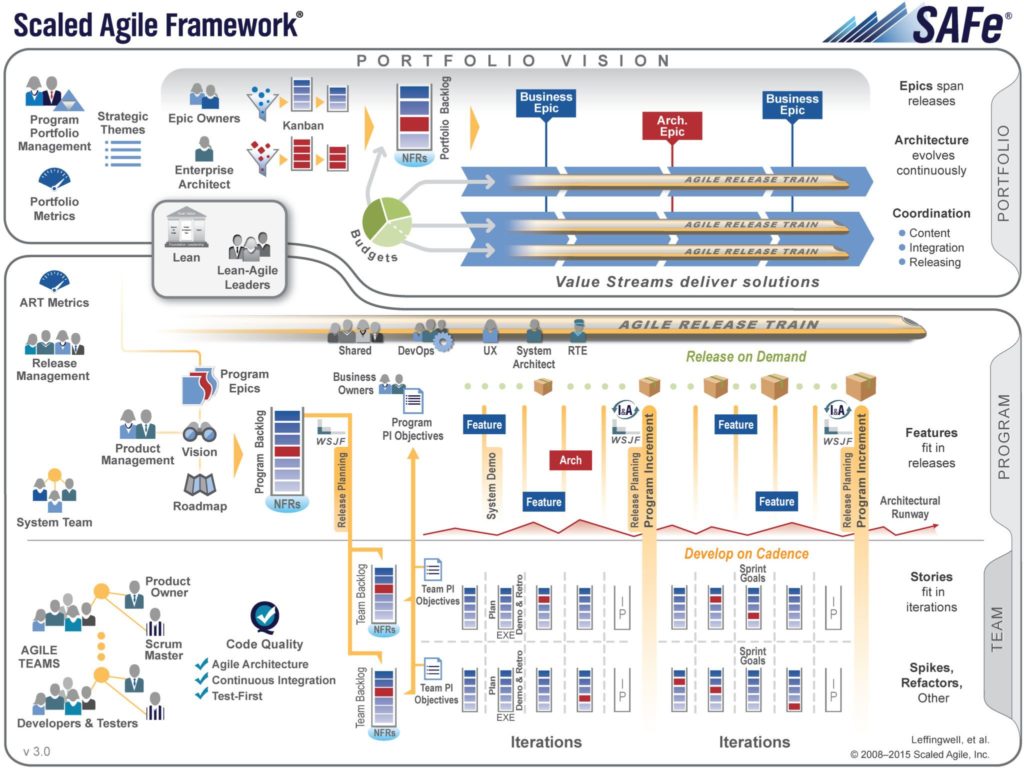There’s been some recent buzz around an Agile process called SAFe®. Have you heard of it? Scaled Agile Framework® (SAFe®) is based on Lean and Agile principles. As a project management framework, it espouses a core set of principles that include:
- Taking an economic view
- Assuming variability
- Preserving options
- Decentralizing decision-making.
SAFe also aims to be a vehicle for enabling organizations to scale Agile development to the enterprise.
I recently spent some time researching SAFe and here are some of the highlights:
Adoption
SAFe adoption focuses on identifying a value stream. Right now, even some United States federal government agencies are adopting Agile programming and DevOps; so SAFe sometimes comes off sounding like real talent for the obvious. However, as an IT contractor might tell you, common sense isn’t always in the driver’s seat of software development projects and enterprise implementations. The body of work behind adopting this framework could be a valuable reference for some enterprises transitioning to an Agile framework. (I also like the questions that SAFe raises around the value stream for service-based companies that want to productize a service or make a similar business transition.)
Adoption focuses on identifying a value stream. A value stream is a sequence of activities intended to produce a consistent set of deliverables of value to customers. According to 41 Things You Need to Know About the Scaled Agile Framework (SAFe) posted on the RallyDev blog, here are the questions to help identify value streams:
- Which program might adopt the new process the fastest?
- Which executives are ready for a transition?
- What is the geographical location, and how are the team members distributed?
- Which programs are the most challenged, or represent the biggest opportunities?
- When you identify a value stream, you go “All In” and “All at Once” for that train.
Value streams are realized via an Agile Release Train (ART). These concepts are going to be obvious for organizations with strong program management, executive, and development teams. I do like them for startups and other organizations making their first steps into a more formal project management framework whether it’s Agile or one of their own creation.
Impact on your project teams
At the project team level, SAFe means Scrum and XP engineering practices for teams that the framework labels as Define/Build/Test (DBT) teams deliver working, fully tested software every two weeks. Teams consist of 5-9 members. Sounds pretty standard to me.
Principle #8 of SAFe is: Unlock the intrinsic motivation of knowledge workers. For some, this is going to be a good review; for others, it’s going to show the framework’s talent for pointing out the obvious.
The framework’s principle to decentralize decision-making is a bright point of the principles. In many bureaucratic organizations, when ideas are brought to management for decisions, it’s often a prelude to their demise. The principle also goes along with some of the moves I’m seeing in the changing role of project managers—where PMs take a strategic role while decentralizing a majority of decisions to the project team.
If you’ve ever had questions on how to roll out a project management framework, the Implementing section of SAFe’s website gives a breakdown of how they implement the framework. While the company ends their implementation process with the prospect of fee-based consulting work, it’s a clear and concise process that you can learn from if you are working in an organization making a move to formalize your project management framework for the first time.
Project portfolio
There are multiple takes on how to use Agile to manage an entire project portfolio that SAFe refers to Program Portfolio Management (PPM). Their stance on PPM provides a good overview of strategic and investment funding; this stance also does a credible job of showing the differences between the traditional approach compared to the Lean-Agile approach to PPM. These differences continue to challenge some enterprises. This section of the framework is good reading for a wide audience of project managers and executive decision makers who are contemplating such a transition in their portfolio management.
Guidance, training, and certification
I do like how SAFe provides lots of documentation about the framework they’ve created. Despite making the crack earlier about their talent for the obvious, the level of detailed documentation they provide makes ideal reading for those seeking to learn more about Agile and Lean development. The guidance they provide is also going to be a good read for even more experienced project managers seeking to broaden their mind about Agile.
Scaled Agile Inc. also offers fee-based training and a certification track for SAFe. As presented, the certification track is pretty encompassing. This framework is still catching on in the Agile world, so laying out the bucks for training and certification might be a bit premature for many enterprises right now.
Final thoughts
I’m from the school of thought that one project management framework doesn’t fit all. So the greater value of this framework is that it gives project delivery organizations an example of how to best align Lean and Agile principles.
Note: SAFe and Scaled Agile Framework are registered trademarks of Scaled Agile Inc.







